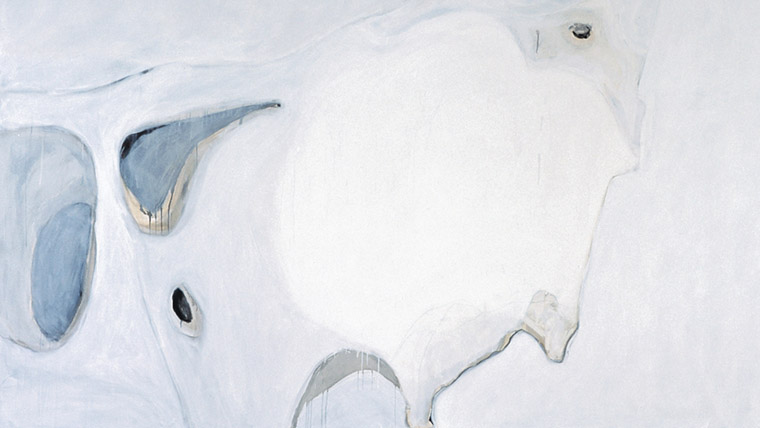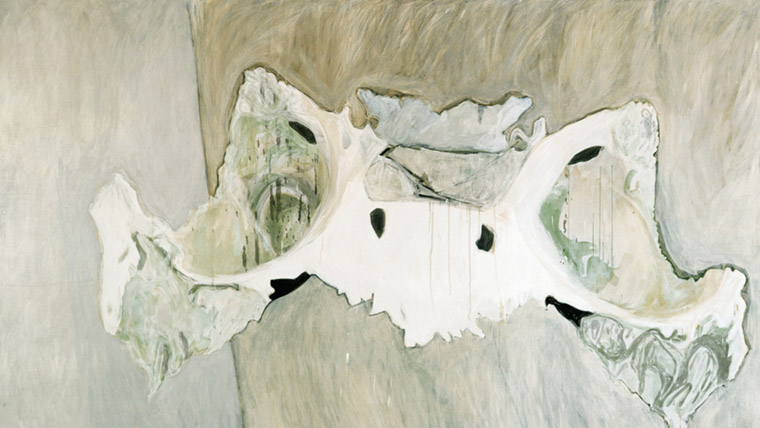Bones, 2005
Paintings (oil, acrylic on canvas), video 7' loop
All of us starts as a pile of bones, as a skeleton scattered all over a desert and covered with sand. Our task is to recover the bones and clean them of sand.
On an endless, wild desert dwells La Loba - a long - haired old woman, who is only able to cackle and croak producing more animal than human sounds. The only activity of La Loba is collecting bones, especially those that belong to endangered species on the Earth. She can often be met stooped, combing through dried riverbeds, endless roads, searching. She is most interested in the bones of wolves. When she has collected all the elements of a skeleton, she assembles it in her cave by the light of fire and the song sung especially for that occasion. The longer La Loba sings the more flesh, skin and hair cover the bones. The Lauder she sings the more life appears in the trembling nostrils. With the next deep breath in the animal rushes out of the cave with a leap and running in to the sun, maybe thanks to its rays, is transformed into a free happy woman. In the symbolism of archetypes, bones are the representation of the lasting and indestructible. In this sense they constitute the connection between the living and the dead. They are a kind of biological story. In the story the bones of wolves symbolize the indestructible aspect of the primeval spirit, natural instincts. La Loba through collecting bones builds spiritual home. Singing our own song, giving vent to our sorrows, desires, experiencing what once was, facing history, trembling for time that runs away, we become. When we spill our soul we are revived.
Everyone has their own history, construction material or maybe a kind of special mass that helps to survive during difficult moments and fulfill one's dreams. Everyone has on their side, generations that give spiritual power. I am, just like any other woman, supported by other women: Mother, Grandmothers, great Grandmothers, aunts. Each of them has built her own spiritual home and telling me about it has given me strength to build my own.
The video I presented is documentary about my Grandmother. It is not essential for the viewer to know the whole story of her life, the continuity of the narration is not important either. The important things are contained in the very concept of a story passed down from generation to generation, which with time becomes fragmentary and incomplete.
True extracting stories out of one's life and the lives of a relative, and from the surrounding world is always connected with overcoming adversities and challenges.
Fragments in italics based on the novel Women who Run with the Wolves, by Clarrisa Pinkola Estes.
The project is presented at the individual exhibition Bones in: BWA Arsenał in Poznań, Artists House in Jerusalem, Art Station Gallery in Poznań.
Kości, 2005
Malarstwo (olej, akryl na płótnie), wideo 7 min pętla
Wszystkie zaczynamy jako kupka kości, jako szkielet rozsypany po pustyni i przysypany piaskiem. Nasze zadanie to wydobyć kości, oczyścić je z piasku.
Bezkresną, dziką pustynię zamieszkuje La Loba - stara kobieta z długimi włosami, która potrafi gdakać i krakać wydając więcej dźwięków zwierzęcych niż ludzkich. Jedynym zajęciem La Loby jest zbieranie kości, przeważnie tych, które należą do zaginionych gatunków na ziemi. Często można ją spotkać zgarbioną, przeczesującą wyschnięte koryta rzek, niekończące się drogi w poszukiwaniu. La Lobę najbardziej interesują kości wilków. Kiedy uzbiera już wszystkie elementy szkieletu, składa go w swojej jaskini przy blasku ognia i pieśni wyśpiewanej specjalnie na tę okazję. Im dłużej La Loba śpiewa, tym więcej ciała, skóry i sierści pokrywa kości. Im mocniej śpiewa, tym więcej życia czai się w rozedrganych nozdrzach. Przy kolejnym głębokim wdechu zwierzę susem wyskakuje z jaskini i biegnąc w stronę słońca zmienia się w wolną, radosną kobietę. W symbolice archetypów kości są reprezentacją trwałego i niezniszczalnego. W tym sensie stanowią łącznik pomiędzy tym co żywe i martwe. Są rodzajem biologicznej opowieści. Kości wilcze w tej opowieści reprezentują niezniszczalny aspekt pierwotnej Jaźni, naturalne instynkty. La Loba zbierając kości buduje duchowe domostwo. Wyśpiewując własną pieśń, dając upust żalom, pragnieniom, przeżywając to co było, stając na przeciw historii, drżąc nad czasem, który biegnie - stajemy się. Kiedy wylewamy duszę ożywamy.
Każdy posiada swoją własną historię, budulec, czy rodzaj specjalnej masy, która pomaga przetrwać ciężkie chwile i urzeczywistnić pragnienia. Każdy posiada za sobą pokolenia dające duchową siłę. Za mną, tak jak i za każdą kobietą, stoją inne kobiety: mama, babcie, prababcie, ciotki. Każda z nich budowała swoje duchowe domostwo a opowiadając mi o tym, dawała siłę do budowania własnego.
Film, który prezentuję jest dokumentem o mojej babci, w którym ciągłość narracji nie jest istotna. To co ważne zawiera się w samej koncepcji opowieści przekazywanej z pokolenia na pokolenie, która z czasem staje się fragmentaryczna i niepełna.
Autentyczne wydobywanie historii z życia własnego i bliskich, z otaczającego świata, wiąże się nieodmiennie z pokonywaniem przeciwności i wyzwań.
Cytaty pisane kursywą pochodzą z książki Biegnąca z wilkami. Archetyp Dzikiej Kobiety w mitach i legendach Clarrisy Pinkoli Estes.
Projekt prezentowany na wystawie indywidualnej Kości w: BWA Arsenał w Poznaniu, Artists House w Jerozolimie, Galerii Art Station w Poznaniu.


